Orchids of Humboldt County, California
In Humboldt County, California there can be found over two dozen native orchids, which is two-thirds of all the native orchids found in California. All of
the orchids found growing in Humboldt County are terrestrial, growing in the soil or in a duff layer on the soil. If you come across one of them while you are
hiking you should remember -
ALL NATIVE ORCHIDS IN CALIFORNIA ARE PROTECTED BY LAW.
These orchids exist in a symbiotic relationship with
mycorrhizal fungi in the soil or duff layer. During the year when there is no above ground plant they are getting the nutrients they need to survive from
the network of mycrorhizial fungi. Those orchids that lack chlorophyll are getting most all the nutrients they need to survive during the whole year from the
network of mycrorhizial fungi. If you dig up a plant you sever the connected living network of the mycrorhizial fungi. Severing that network leads to eventual
death of the mycorrhizal fungi which in turn will lead to the death of that orchid plant.
REMEMBER - ONLY COLLECT PHOTOGRAPHS, NOT PLANTS.
Images on this page were downloaded from INaturalist.com.
They are notated with their appropriate copyright license information.
Fairy Slipper Orchids
The plants are produced from a small bulbous corm about 1/2 to 3/4 inches in size that has only a few
fleshly roots. With an inflated labellum the Fairy Slipper orchids appear similar to Lady Slipper orchids, however DNA analysis shows that
they are not related. The genus Calypso is a monotypic genus, meaning that there is only one species in this genus, however it is circumpolar
in distribution with four slightly different varieties found in Eastern and Western North America, Eurasia and Japan.
Calypso bulbosa var. occidentalis
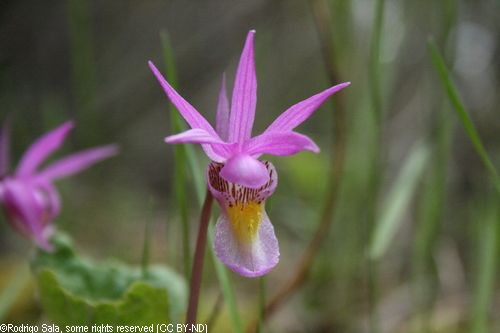
The common name is Western Fairy Slipper. Usually found in shady forest locations with moss or rotting humus.
The plants arise from a tiny tuber or corm with few slender, brittle roots. In early spring a single dark green satiny leaf is produced
and then a single frost-resistant 8-10 inch flower stem is produced. Only one two inch flower is produced which is usually medium pink
in color. The flower color can vary greatly from white to light pink to a dark pink. Flowering typically occurs from May into July.
Lady Slipper Orchids
The plants arise from a fibrous rhizome with roots that are covered with fine hairs. Each year multiple
upright multi-veined or pleated leaves are produced from either the base of the flowering stem or along the stem. The flowers are usually showy
and are borne singly or up to as many as twelve per stem. Even though the flowers look inviting to us they apparently do not offer the
pollinating insect any true nectar, only viscid droplets of fluid that cling to the hairs on the inside of the labellum. The common name for the
genera is based on the idea that the inflated labellum resembles a ladies slipper.
Cypripedium californicum
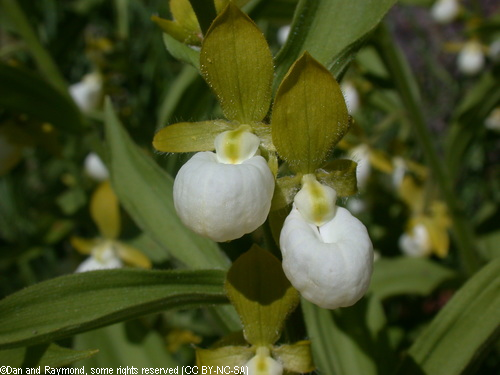
The common name is California Lady's-slipper. Usually found along shady mountain streams or springs, quite often
with the pitcher plant Darlingtonia californica. Plants arise from a creeping rhizome, the lower half of the flower stem has large
alternately produced leaves and the upper half may have twelve or more flowers. The flowers can be three inches across, with light yellow
or greenish sepals and a white labellum. The plants can be up to four feet tall. Flowering typically occurs from May into July.
Cypripedium fasciculatum
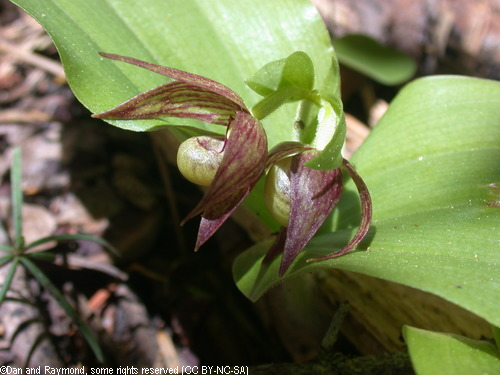
The common name is Clustered Lady's-slipper. Usually found in forests at moderately high elevations where winters
are not too severe. Plants arise from compact rhizomes to produce two rather large leaves. The flower stems are rather weak resulting in
the two to four two inch flowers bending over the leaves. The whole flower is brownish or purplish in color making it the least attractive
Lady-slipper. Plants usually only twelve inches tall. Flowering typically occurs from April into July.
Cypripedium montanum
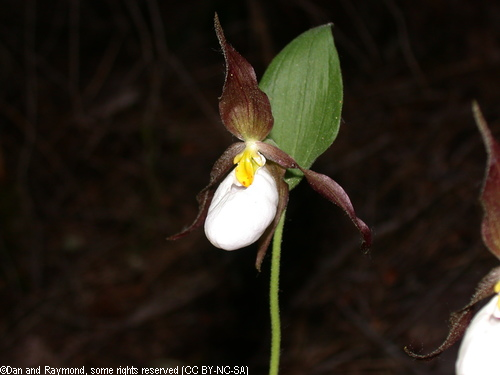
The common name is Mountain Lady's-slipper. Usually found in moist or dry open woods at moderately high elevations
in sunny or shady locations. The plants arise from short rhizomes that produce flower stems with four to six pubescent leaves and one to
three four to five inch flowers. The sepals are brownish or purplish in color and twisted and the labellum is white or may have a faint
purplish suffusion. The plants can be up to thirty inches tall. Flowering typically occurs from May into July.
Ladies'-Tresses Orchids
The plants are borne from a mass of fibrous or fleshy roots that first produce some basal leaves while the
flower stem is being produced, however they wither and are absent by the time the flowers open. The common name was given some two hundred years
ago because the sprialing flower stem resembled a woman's braided hair.
Spiranthes porrifolia
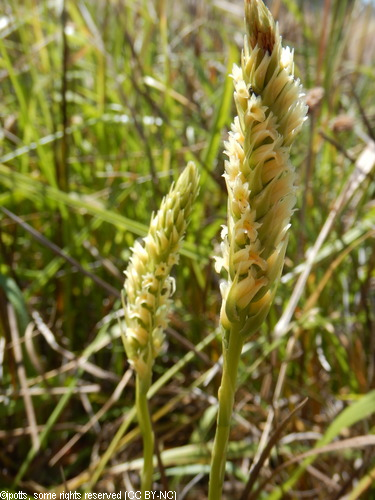
The common name is Western Lady's-tresses. Usually found along streams, in bogs and on seepage slopes. The plants
arise from fleshy roots that produce three to four small basal,, slick, shiny succulent leaves. At the top of the flower stem a spiral of
three overlapping vertical ranks of flowers is produced. The light yellowish flowers are tightly grouped on the stem and less than half
an inch wide. The plants may grow to twenty inches tall and may have three dozen or more flowers. This species has a rather small
distribution of northern and the north Sierra's of California and the Cascade range in central Oregon. Flowering typically occurs from
May to August.
Spiranthes romanzoffiana
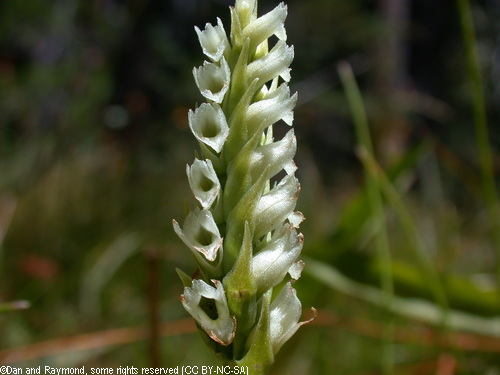
The common name is Hooded Lady's-tresses. Usually found along streams, in bogs and on seepage slopes. The plants
arise from fleshy roots that produce three to six small basal leaves. At the top of the flower stem a spiral of three overlapping
vertical ranks of flowers is produced. The white flowers are tightly grouped on the stem and less than half an inch wide. The plants
may grow to twenty inches tall and may have three dozen or more flowers. This species has a rather large distribution from Alaska, all
across Canada and the Northwest. Flowering typically occurs from July to October.
Twayblade Orchids
These species are characterized by a slender stem that is produced from a mass of several fibrous roots. The
stem bears a pair of opposite leaves about half way up the stem, hence the common name twayblade. Above the leaves the small flowers are borne
in a loose raceme. When a pollinating insect touches a specific part of the lip a minute quantity of quick-drying cement is discharged which
catches the tips of the pollinia and is then deposited on the insect. The cement dries in only a few seconds and the whole incident usually
frightens the insect so it flies off to another flower.
Neottia banksiana
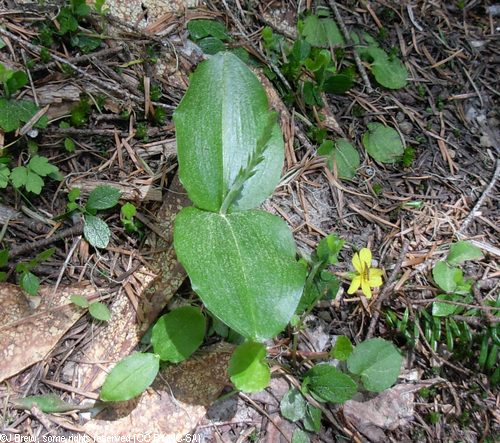
The common name is Northwest Twayblade. Usually found in cool dark coniferous forests with rich needle litter.
The plants arise from fleshy roots that produce two oppisite three inch green leaves. Up to about two dozen yellowish green, one quarter
inch flowers are produced on a slender, but stout stem. The apex of the lip is rounded instead of being indented or cleft into tails like
other twayblades. The flower stem may grow to ten inches tall. Flowering typically occurs from June to August.
Neottia convallariodes
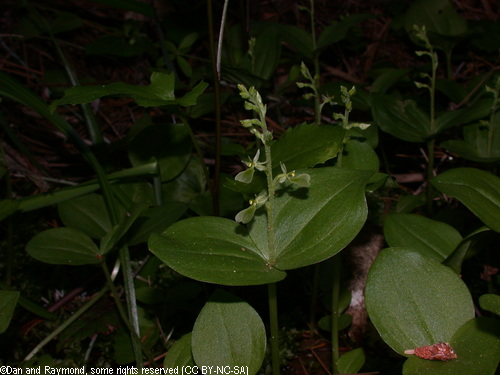
The common name is Broad-leaved Twayblade. Usually found in low elevation, moist woods, especially around
depressions, however it may be found in forests or boggy meadows.The plants arise from a few fleshy roots that produce two opposite three
inch green leaves. Up to about twenty yellowish green, one half inch flowers are produced on a slender, but stout stem. The flower stem
may grow to over one foot tall. Flowering typically occurs from June to August.
Neottia cordata
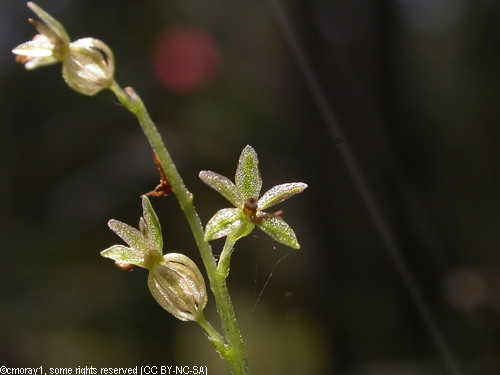
The common name is Heart-leaved Twayblade. Usually found in cool dark coniferous forests with a mossy turf or in
sphagnum bogs. The plants arise from a few fibrous roots. The typical variety has a slender fragile stem that may reach ten inches tall
with two tiny one half inch dark green leaves. The stem may bear up to 25 mosquito-sized (1-2 cm) flowers that can be anywhere from green
to reddish purple in color. A more robust variety may also be found that has flowers that are twice as big (3-4 cm) in size and are only
green to light green in color. The leaves are twice as big and may be reticulated and the overall plant size will be just over a foot tall.
The typical variety usually flowers in late May to August, whereas the robust variety usually flowers in June to July.
Rattlesnake Plantain Orchids
The plants arise from a horizontally creeping rhizome that produces roots at intervals along the rhizome. At
the end of the rhizome a rosette of leaves is produced that is variously marked with silvery white. When this rosette matures it will produce a
flower stem from its center. The leaves will later wither and die, the rhizome will branch and mature in later years. This branching habit can
produce compact colonies of numerous rosettes of leaves.
Goodyera oblongifolia
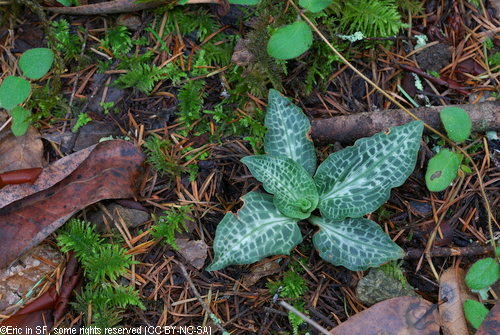
The common name is Menzies' Rattlesnake Plantain. Usually found in leaf litter of dry or moist hardwood or coniferous
forests. The rosette of bluish-green leaves is marked by a broad silvery-white stripe on the mid-vein of the leaf and reticulated markings
on the rest of the leaf. A single flower stem can have up to thirty greenish-white flowers that are almost one-half inch in size. Overall
size of the plant can be just over one foot tall. Flowering typically occurs from July to September.
Chatterbox Orchids
The plants arise from a short underground rhizome which is supported by fibrous roots. The plant produces large
alternating leaves that decrease greatly in size as they go up the flower stem. The rather large lip is capable of moving up and down in a slight
breeze.
Epipactis gigantea
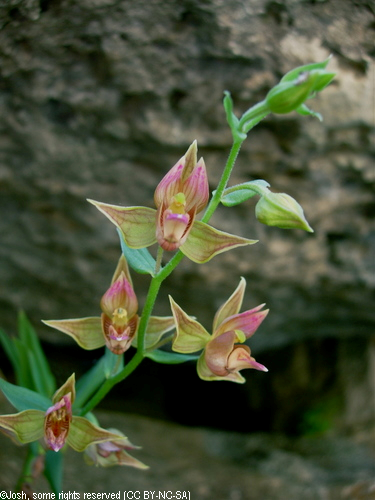
The common name is the Chatterbox Orchid. Usually found in gravel beds or sand-bars along streams that are inundated
during wet seasons or along seepage banks or around springs. The somewhat coarse leafy stems are produced each year. Up to fifteen flowers
are spaced rather distantly along the stem and are only about two inches in size. The colorful flowers have petals that are rose colored at
the base and trend to green and the lip is yellowish with purple to brownish veining. Overall height to three feet tall. Flowering typically
occurs from March to August.
Coral-Root Orchids
The plants are borne from fragile, multibranched, warty rhizomes. These orchids appear to have small amounts of
chlorophyll or have chlorophyll-like substances in the stems. Multiple flower stems are usually produced that terminate in a loose or dense raceme of
usually small flowers. The rhizomes live in symbiosis with mycorrhizal fungi in the soil or duff layer where they are growing. Flower stems are not
produced each year and may not be produced for a number of years until a mature rhizome gets sufficient rainfall, similar to the Phantom orchids.
Corallorhiza maculata
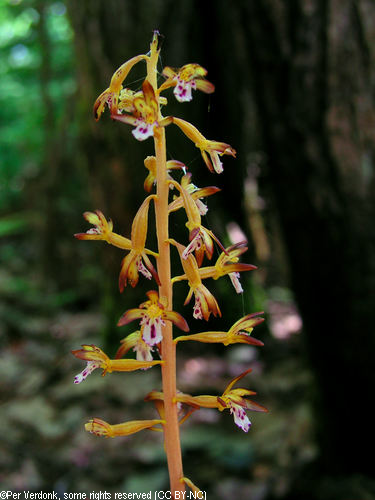
The common name is the Spotted Coral-root orchid. This species is the most commonly found and the most variable in
appearance of all coral-roots. Usually found in humus of shady woods, most often coniferous but also hardwoods. When conditions allow a
thick-based stem is produced that only have a few papery sheaths at the base, no leaves. The color of the flower stem varies from deep purple
through reds and brown to yellow. The base color of the nearly one inch flowers usually matches the color of the stem with the sepals and
petals being orange-brown marked with purple. The white lip is prominently marked with red violet spots, however sometimes the spots are
lacking. Flower stems may grow to two feet or more and quite often multiple flower stems will be produced. Flowering typically occurs from
April to September if conditions are right.
Corallorhiza mertensiana
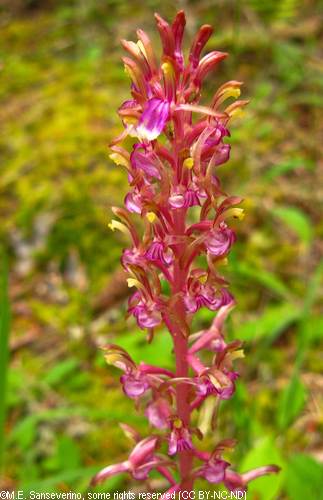
The common name is the Pacific Coral-root orchid. This species is considered one of the prettiest of the coral-roots.
Usually found in humus of cool wet shady woods and may appear as large colonies or compact clusters. When conditions allow a rather slender
stem is produced that only have a few papery sheaths at the base, no leaves. The color of the flower stem is usually reddish, but can vary
from deep purple through reds and brown to yellow. Flower stems to two feet tall with up to forty colorful one inch flowers on the upper half
of the stem. Flowering typically occurs from June to August if conditions are right.
Corallorhiza striata
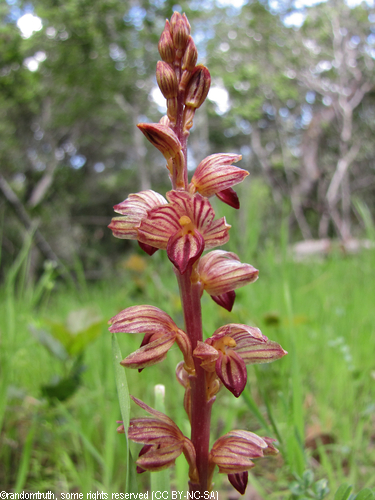
The common name is the Striped Coral-root orchid. Usually found in humus of cool shady cedar or mixed wood forests
favoring areas near limestone. When conditions allow a rather slender stem is produced that have a tubular papery sheath on the lower half.
Flower stems to twenty inches tall with up to thirty-five flowers that are just over one inch in size, making them the largest flowers of the
genus. The color of the flower stem is usually reddish, but can vary from deep purple through reds and brown to yellow. Flowering typically
occurs May to August if conditions are right.
Phantom Orchids
These orchids lack chlorophyll and are totally dependent on mycorrhizal fungi in the soil or duff layer to provide
nutrients to survive, grow, and flower. These orchids do not appear every year, only after the sub-terranean, fungi infected rhizome has matured for
a number of years, gathered enough nutrients, and gets sufficient rainfall will the plant produce flowering stems. The flower stems have a cool, clammy,
wax-like feel when touched
Cephalanthera austinae
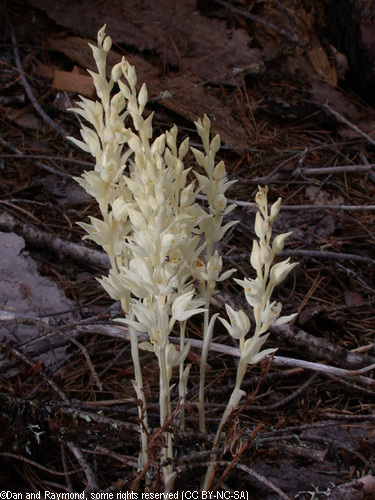
Common name is Phantom orchid. They are found in rotting humus of very shady forests. The flower stems can start
appearing in spring or summer. Flower stems are white and the flowers are also white except for a small yellowish patch on the lip. The
flower stems can reach two feet tall and may have up to 20 flowers. The flowers are about two inches in size, the sepals and petals do not
spread widely like many orchids so that the inner half of the lip is not visable. If it flowers, the typical flowering season is June to
August depending on the rainfall.
Bog and Rein Orchids
In the past the Bog and Rein orchids were separated into two genera, however DNA analysis has revealed that they
should not be seperated. In combining the Bog and Rein orchids into the one genus of Platanthera it now has more species than any other genera in
North America.
The Bog orchids are borne from a fascicle of fleshy, tapered or swollen roots that support an erect stem with basal leaves. The flower stem is
terminated by a raceme of medium-sized or small flowers. The petals and dorsal sepal tend to create a hood over the column and the base of the labellum
developes into a nectar spur of vairing length.
The Rein orchids are borne from a pair of fleshy ovoid tubers that support an erect stem with a few basal leaves. The flower stem is terminated by
either a loose or congested group of small flowers that have nectar spurs similar to the Bog orchids.
Platanthera dilatata
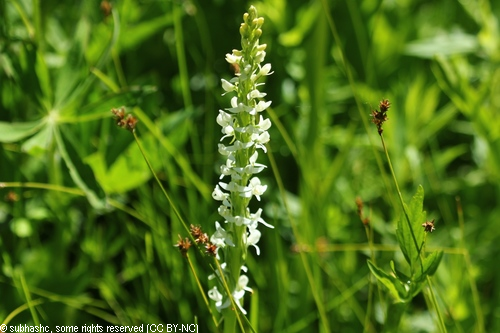
Common name is White Bog orchid. They are found in sunny wet bogs, marshes or meadows. Plants arise from fleshy roots
with about twelve one foot long narrow leaves. Plants can grow to over three feet tall with many white one inch flowers. The flowers have a
prominent nectar spur that can range from just over half the length of the lip to two times the length. The flowers emit a strong clove-like
fragrance. Flowering typically occurs from May to August.
Platanthera stricta
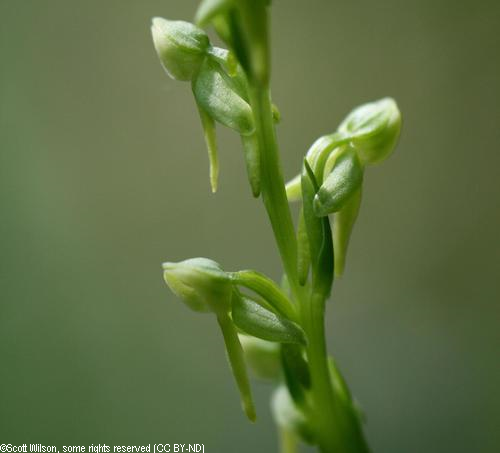
Common name is Slender Bog orchid.They are found in moist or damp areas in meadows or along streams in shady or sunny
locations. Plants arise from fleshy roots with about ten one foot long narrow leaves. Plants can grow to over three feet tall with many green
colored flowers that are about one half inch in size. The nectar spur is only about half the length of the lip and is terminated with a bulbous
sac. Flowering typically occurs from May to September.
Platanthera sparsiflora
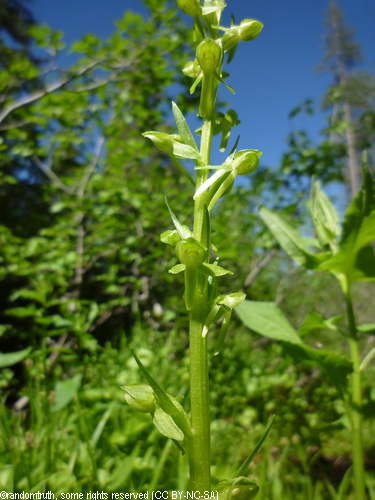
Common name is Sparse Flowered Bog orchid. Found in usually very wet habitats and is sometimes found with the pitcher
plant Darlingtonia californica. Plants arise from fleshy roots with about ten one foot long narrow leaves. Plants can grow to about
thirty inches tall. The flowers are green in color and while there are many of them they are widly spaced on the stem. The nectar spur is as
long or longer than the lip. Flowering typically occurs from April to September.
Platanthera tescamnis
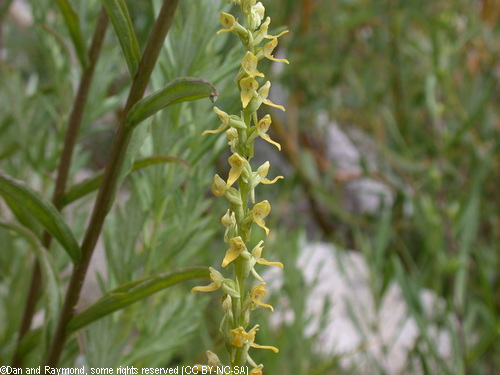
Common name is Intermountain Bog orchid. Found in somewhat moist or damp areas in meadows in shady or sunny locations.
Plants arise from fleshy roots with about ten one foot long narrow leaves. Plants can grow to over three feet tall with many yellow-green
flowers about one half inch in size. The nectar spur is about as long as the lip or shorter. Flowering typically occurs from June to August.
Platanthera elegans
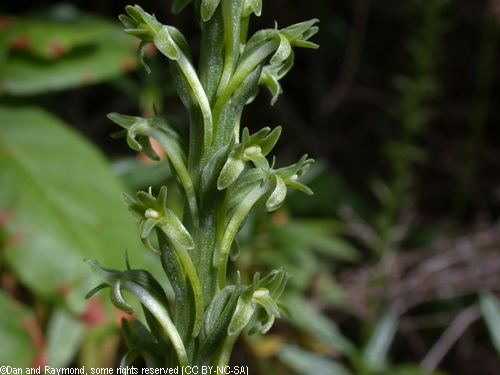
Common name is Elegant Rein orchid. Found in leafy humus of open woods, in ravines, low elevation mountainsides and
sometimes along coastal areas. The plants arise from a pair of tuberoids with fleshy roots. A few basal leaves are produced early on, however
they wither away before flowering begins. The stout flower stem may grow to three feet tall with up to 100 flowers that are white to light
green. The flowers are just over one half inch in size. Flowering typically occurs from May to October.
Platanthera elongata
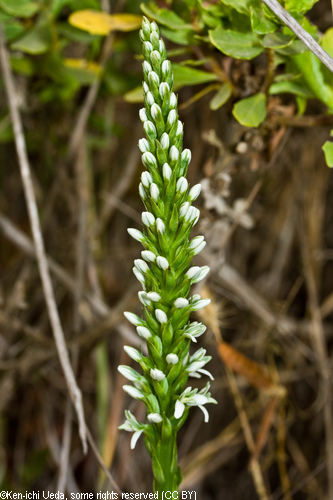
Common name is Denseflower Rein orchid. Found along coastal cliffs exposed to winds and fog among other dwarfed
vegetation. The plants arise from a pair of tuberoids with a few fleshy roots to produce three to five leaves about six inches long in early
spring, however by flowering they are totally desiccated. The flower stem may grow to over three feet tall with up to 100 light green flowers
that are marked with a green stripe on the sepals and petals. The flowers are just under one quarter inch in size and are lightly fragrant
in the evening. Flowering typically occurs from May to September.
Platanthera ephemerantha
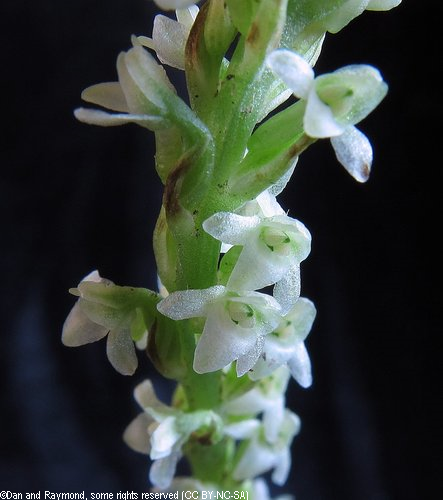
Common name is Whiteflower Rein orchid. Found in coniferous and mixed forests. The plants arise from tuberoids to
produce two to five small leaves in early spring, however by flowering they are totally desiccated. The flower stem may grow to almost two
feet tall with up to one humdred white, slightly fragrant flowers that are just under one half inch in size. As the name suggests the flowers
only last for a short time. Flowering typically occurs from May to August.
Platanthera michaelii
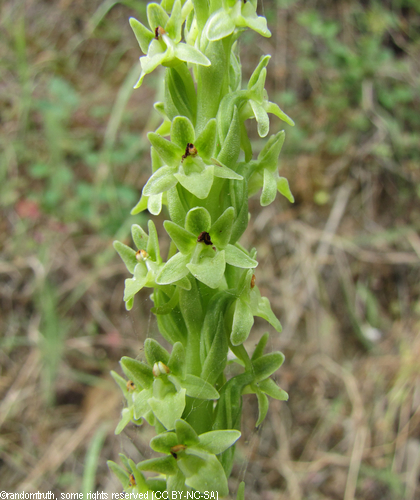
Common name is Michael's Rein orchid. Found in shady forests, shrublands or mixed forests, The plants arise from
tuberoids to produce three or four small leaves in early spring, however by flowering they are totally desiccated. The flower stem may grow to
just over two feet tall with twenty to sixty yellow-green flowers that are just under one inch in size. The flowers are fragrant in the
evening. Flowering typically occurs from April to August.
Platanthera transversa
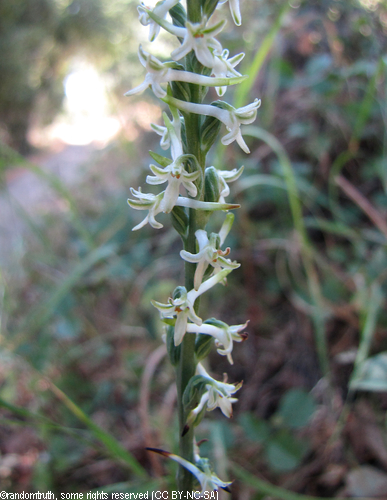
Common name is Flat Spurred Rein orchid. Found in dry sites, including scrub and ork woodlands or conifer forests. The
plants arise from tuberoids to produce two small leaves in early spring, however by flowering they are totally desiccated. The flower stem may grow
to about two feet tall with up to ninety white to yellow flowers with green midveins on sepals and petals. The flowers are less than one half inch
in size and are fragrant at night to attract moths for pollination. Flowering typically occurs from May to August.
Platanthera unalascensis
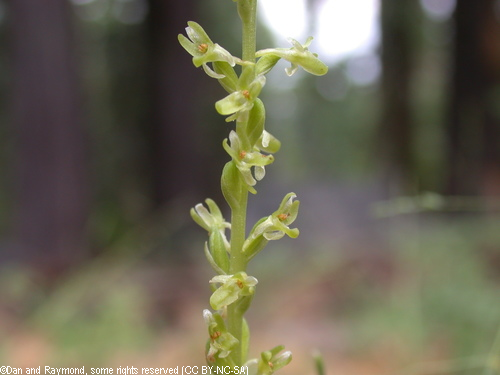
Common name is Slender-spire Rein orchid. Found in shady forests to open meadows or dry rocky hillsides. The plants
arise from a pair of ovoid tubers with a few slender fleshy roots to produce two to four leaves that emerge in early spring, however by flowering
they may be desiccated. The slender flower stem can grow to just over two feet tall with minute greenish or straw-colored flowers that on the
lower two-thirds of the stem are distantly spaced and more crowded near the top. The flowers are about one quarter inch in size and will appear
tipped to one side or the other in relation to the stem. Flowering typically occurs from April to August.
























